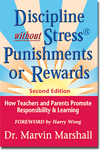|
 |
| Teachers.Net Gazette Vol.6 No.2 | February 2009 |
Subscribe for free home delivery |
|
How to Be Consistent Although consistency is important, imposing the same consequence on all students is the least fair approach. | |
| by Dr. Marvin Marshall www.MarvinMarshall.com Regular contributor to the Gazette February 1, 2009 |
|
|
 A significant trait that teachers, students, and parents are concerned about is being consistent. “How can I be fair, firm and CONSISTENT?” was a question I continually asked myself--not only as a teacher, but especially as an assistant principal of supervision and control in a high school of 3,200 students. The question was also on my mind when I disciplined students as a middle school assistant principal and as an elementary school principal. Only when I returned to the classroom after 24 years in counseling and administration did I realize that my mindset of being consistent in dispensing punishments was unfair and highly inconsistent. Think of the person who needs an appendectomy. The operation costs so many dollars and is easy for the wealthy to afford the operation. This person has an excellent health policy that would pay for the operation. In contrast, person B also needs the same type of operation, has no health insurance, and is unemployed. Is it fair to charge both the same for the operation? The question is an unfair one because of so many considerations, but our immediate reaction is that charging the same when the circumstances are so different would be unfair. However, the example serves a purpose for reflecting on how we treat young people in school (and in the home). When we are consistent in imposing the same consequence on every student, are we being fair or unfair? Although consistency is important, imposing the same consequence on all students is the least fair approach. When a consequence is imposed--be it called logical or natural--people are deprived of ownership in the decision. And ownership is a requirement for responsibility. A more effective and fairer approach is to elicit a consequence or a procedure that will help students redirect impulses so they become more responsible. This is easily accomplished by asking students if they would rather be treated as individuals or as a group. They will have a preference to be treated as individuals and have ownership in the decision that will help them--rather than hurt them. This approach satisfies the consistency requirement and is in each person's best interests. In short, consistency in process (procedure) is fairer than consistency in outcome. The process is quite simple. Inform the student that the behavior is on a level that is unacceptable and ask, “What do you suggest we do about it?’ Then be ready to follow-up with, “What else?” “What else?” “What else?” until the youngster comes up with a procedure or consequence that you both agree will help the youngster in not repeating the inappropriate behavior. Another basic factor is also at work here. People do not argue with their own decisions. If parents insist on knowing consequences ahead of time, use the same approach. Simply ask the parents if they would rather have their child treated individually according to what will help their child in the future, or would they rather have their child treated as a part of a larger group where usually everyone will have the same imposed punishment. Many parents do not realize that imposing punishments is based on the antiquated idea that a person has to be hurt to learn, to be harmed in order to change. It is the responsibility of the teacher, the professional, to teach parents in such cases. This is easy to do. As noted above, simply as the same question to the parent as is asked of the student. The point is important enough to repeat: Consistency in process (procedure) is more just and fair than consistency in outcome. Copyright © 2009 Marvin Marshall. More on the approach can be viewed here: PREVIEW. and at www.MarvinMarshall.com.
| |
|


 His approach is the only system that is proactive, totally noncoercive, and does not use external manipulatives or threats. He INDUCES students to WANT to act responsibly and WANT to put forth effort to learn.
His approach is the only system that is proactive, totally noncoercive, and does not use external manipulatives or threats. He INDUCES students to WANT to act responsibly and WANT to put forth effort to learn.
